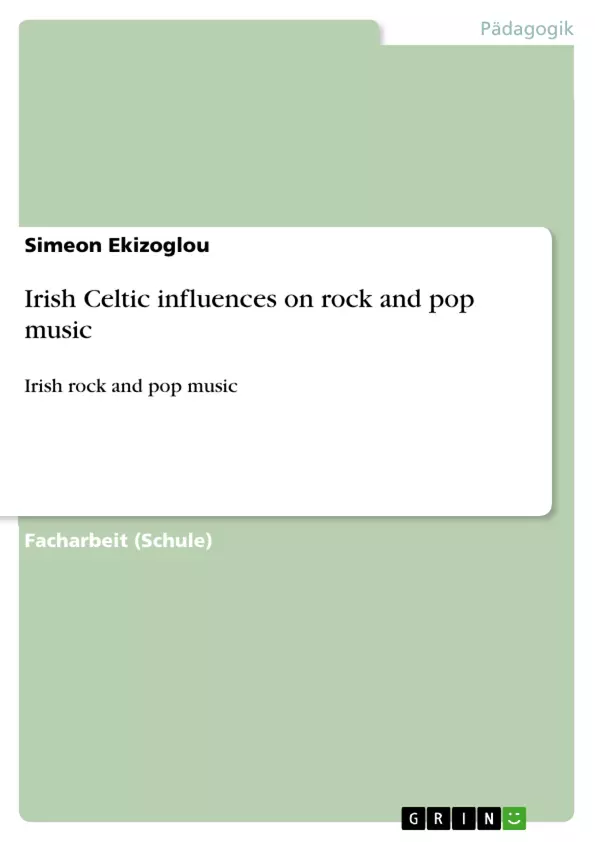Irish Celtic traditional music has been a typical identification mark for Irish people and the other Celtic nations for a long time. Even today the terms “Celtic“ and “Irish“ are very common in the music business and especially in the rock and pop sector. This is because since the 1960s a lot of bands have combined traditional elements of folk music with rock and pop which is known worldwide and this way the bands created new genres. The famous Celtic rock band Horslips made the first step by mixing elements in this manner and the U2 carry on this phenomenon with their music being one of the most famous in the world.
The main theme of this research paper is presenting the Irish Celtic traditional folk music and its characteristics and pointing out how it has influenced the rock and pop music. Examples will be given with famous bands that have incorporated these influences and connected them with idioms of various styles of rock and popular music. The focus is set on Ireland because it is most famous for its Celtic music and therefore plays an essential role.
Inhaltsverzeichnis
- A Introduction
- B Irish Celtic influences on rock and pop music
- 1. What is Celtic music?
- 1.1 Celtic nations and their common musical heritage
- 2. Music of Ireland
- 2.1 Traditional Irish Celtic music and its characteristics
- 2.2 Instruments
- 2.2.1 Fiddle
- 2.2.2 Whistles and flutes
- 2.2.3 Banjo
- 2.2.4 Bagpipes
- 2.2.5 Harp
- 2.2.6 Accordion
- 2.2.7 More instruments and their use
- 2.3 Irish rock and pop music
- 2.3.1 Showbands
- 2.3.2 Celtic fusion - Irish traditional elements in popular rock and pop songs
- 3. Famous Irish fusion bands and artists
- 3.1 Horslips
- 3.2 The Pogues
- 3.3 International success - Morrison, Gallagher, Moore and Lynott
- 3.4 U2 - Irish identity and international success
- 2,4. New generation Celtic fusion
- 4.1 Dropkick Murphys, Eluveitie, Flogging Molly
- C Conclusion
- D Bibliography
Zielsetzung und Themenschwerpunkte
Diese Seminararbeit untersucht den Einfluss der traditionellen irisch-keltischen Musik auf Rock- und Popmusik. Das Hauptziel ist es, die Charakteristika der traditionellen irischen Musik aufzuzeigen und zu analysieren, wie diese Elemente in die moderne Musik integriert wurden. Die Arbeit konzentriert sich dabei auf Irland als zentralem Vertreter der keltischen Musiktradition.
- Charakteristika der traditionellen irisch-keltischen Musik
- Integration traditioneller Elemente in Rock- und Popmusik
- Einflussreiche irische Bands und Künstler
- Entwicklung der keltischen Fusion im Laufe der Zeit
- Die Rolle Irlands in der keltischen Musiktradition
Zusammenfassung der Kapitel
A Introduction: Die Einleitung führt in das Thema ein und beschreibt die weitreichende Verwendung der Begriffe "Celtic" und "Irish" im Musikgeschäft, besonders im Rock- und Popsektor. Sie betont die Kombination traditioneller Folk-Elemente mit Rock und Pop seit den 1960er Jahren und nennt Horslips und U2 als prägende Beispiele für diese Entwicklung. Der Fokus liegt auf der Darstellung der traditionellen irischen Musik und deren Einfluss auf Rock und Pop, wobei Irland aufgrund seiner prominenten Rolle in der keltischen Musiktradition im Mittelpunkt steht.
B Irish Celtic influences on rock and pop music: Dieses Kapitel analysiert den Einfluss keltischer Musik auf Rock und Pop. Es beginnt mit einer Definition von "Celtic Music" und beleuchtet das gemeinsame musikalische Erbe der keltischen Nationen, unterstreicht dabei die Besonderheiten der irischen Musik. Im Folgenden werden traditionelle irische Instrumente, musikalische Elemente (z.B. Tonarten, Rhythmen) und verschiedene Musikformen (z.B. Tanzmusik) detailliert beschrieben. Schließlich werden berühmte irische Fusion-Bands und Künstler vorgestellt, die traditionelle Elemente mit Rock und Pop kombinieren und so neue Genres schaffen.
Schlüsselwörter
Irisch-keltische Musik, traditionelle Musik, Rockmusik, Popmusik, Celtic Fusion, Irland, Musikinstrumente, Folkmusik, Showbands, U2, Horslips, The Pogues, Dropkick Murphys, Eluveitie, Flogging Molly.
Häufig gestellte Fragen (FAQ): Irisch-keltische Einflüsse auf Rock- und Popmusik
Was ist der Gegenstand dieser Seminararbeit?
Die Seminararbeit untersucht den Einfluss traditioneller irisch-keltischer Musik auf Rock- und Popmusik. Der Fokus liegt dabei auf Irland und der Analyse, wie traditionelle irische Musikelemente in moderne Musikgenres integriert wurden.
Welche Themen werden in der Arbeit behandelt?
Die Arbeit behandelt die Charakteristika traditioneller irisch-keltischer Musik, die Integration traditioneller Elemente in Rock und Pop, einflussreiche irische Bands und Künstler, die Entwicklung der keltischen Fusion im Laufe der Zeit und die Rolle Irlands in der keltischen Musiktradition.
Welche Kapitel umfasst die Arbeit?
Die Arbeit gliedert sich in eine Einleitung (A), ein Hauptkapitel zu irisch-keltischen Einflüssen auf Rock und Popmusik (B), eine Schlussfolgerung (C) und ein Literaturverzeichnis (D). Kapitel B beinhaltet detaillierte Beschreibungen traditioneller irischer Instrumente, Musikformen und bedeutender Fusion-Bands.
Welche Instrumente der traditionellen irischen Musik werden behandelt?
Die Arbeit beschreibt verschiedene traditionelle irische Instrumente wie die Fiddle, Whistles und Flöten, Banjo, Dudelsack (Bagpipes), Harfe, Akkordeon und weitere.
Welche bekannten irischen Bands und Künstler werden erwähnt?
Die Arbeit nennt und analysiert Bands und Künstler wie Horslips, The Pogues, U2, sowie Vertreter der neuen Generation der keltischen Fusion wie Dropkick Murphys, Eluveitie und Flogging Molly. Die Bedeutung von Künstlern wie Morrison, Gallagher, Moore und Lynott wird ebenfalls angesprochen.
Was ist "Celtic Fusion"?
Celtic Fusion beschreibt die Kombination traditioneller keltischer Musikelemente mit Rock- und Popmusik. Die Arbeit analysiert die Entwicklung und den Erfolg dieses Genres.
Was ist das Ziel der Arbeit?
Das Hauptziel der Arbeit ist es, die Charakteristika der traditionellen irischen Musik aufzuzeigen und zu analysieren, wie diese Elemente in die moderne Musik integriert wurden.
Welche Schlüsselwörter beschreiben den Inhalt der Arbeit?
Schlüsselwörter sind: Irisch-keltische Musik, traditionelle Musik, Rockmusik, Popmusik, Celtic Fusion, Irland, Musikinstrumente, Folkmusik, Showbands, U2, Horslips, The Pogues, Dropkick Murphys, Eluveitie, Flogging Molly.
Wie wird die traditionelle irische Musik in der Arbeit beschrieben?
Die Arbeit beschreibt traditionelle irische Musik umfassend, inklusive ihrer Instrumente, musikalischen Elemente (Tonarten, Rhythmen) und verschiedener Musikformen (z.B. Tanzmusik).
Welche Rolle spielt Irland in der keltischen Musiktradition laut der Arbeit?
Die Arbeit betont die prominente Rolle Irlands innerhalb der keltischen Musiktradition und konzentriert sich deshalb hauptsächlich auf irische Musik und deren Einfluss.
- Citar trabajo
- Simeon Ekizoglou (Autor), 2012, Irish Celtic influences on rock and pop music, Múnich, GRIN Verlag, https://www.grin.com/document/211986



